
|
Note ye ed's email address: stevebryant99@gmail.com. |

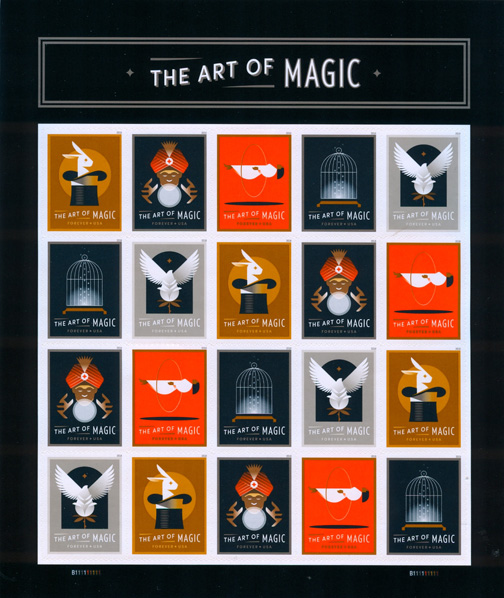
Magical postage.
|
Return to our August issue for a look at MAGIC Live 2018, Steve Spill's new book of parlor magic, Rob Zabrecky's ABC lecture in print, Justin Willman on stage, Danny Cole on video, and we bid farewell to David Linsell. |
September 2018 This month we are going postal, at least with regard to the headlines. We celebrate the Art of Magic stamps and associated souvenirs from the USPS, we appreciate two fine magicians who put the special into Special Delivery, we learn from two more fine magicians who always seem to know what each other is thinking, and we list the Allied Arts that make over a dozen more magicians unique. Coming soon to Bloomington IN: Simon Coronel starring in Glitches in Reality (Sept 21 to Oct 5) and Steve Martin and Martin Short (Sept 22). Can't wait! And finally, a very happy 60th birthday to Amazing Johnathan. |
|
|
STAMPS OF APPROVAL -- I love the United States Postal Service. For over 60 years they have delivered magic tricks to my door. What a thrill it was in high school to receive The Magic of Matt Schulien, in a box from Ireland Magic. Or Harry Lorayne's Close-up Card Magic. Or Steranko on Cards. Wow. As reported last month, in keeping with the new Art of Magic stamps introduced to the world at MAGIC Live, the post office itself now offers some serious magic swag. Central to their offerings is the sheet of stamps themselves, forever stamps celebrating five magical effects: Production, Prediction, Levitation, Vanishing, and Transformation. 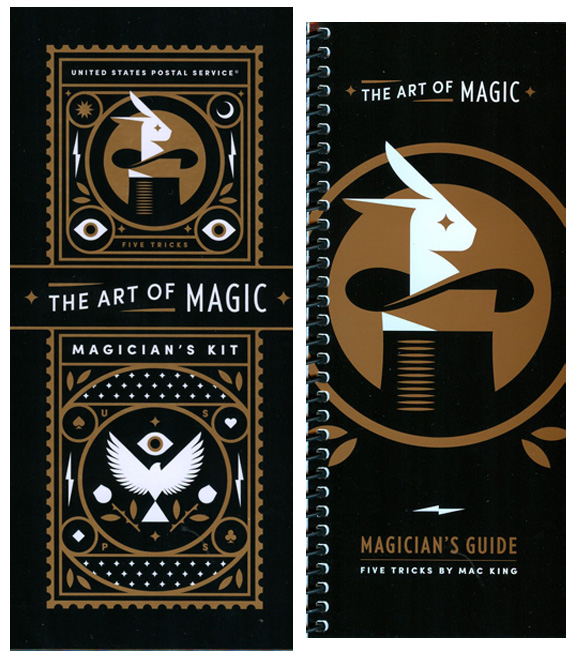 Magic kit and manual. But wait, there's more. For $34.95 you get a complete magic set. The kit includes a Magician's Guide (a booklet by Mac King explaining five tricks that Mac performs on the internet), a strip of the five Art of Magic stamps, a fabulous deck of cards including special cards to do the tricks, all packaged in an attractive Drawer Box, a trick itself. The five tricks constitute examples of the five core effects. 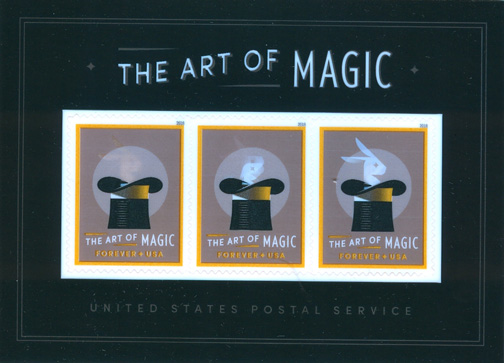 Strip of lenticular stamps. And still more. For $1.50 you can purchase three lenticular stamps that transform. Or framed renditions of any stamp (7 by 11.5 in) for $14.95, or poster-sized renditions (18 by 24 in) for $19.95. Keen. I have so far ordered the kit and the lenticulars. All products are impressive. Check in with Mac King and see what the cool kids are learning. OVERNIGHT SUCCESSES -- Delivery in a magic show becomes special when the performer is in total rapport with the audience, with unscripted, or at least so it seems, verbal interaction with the spectators. In other words, the show is happening now, what is happening is real, and is not phoned in. Among the acts I've recently enjoyed on YouTube, two such performers strike me as the ultimate examples. The first is Whit Pop Haydn working at the Magic Castle. His interplay with the audience is a marvelous mix of wit, facial expressions, and Southern accent. As he explains in his recent podcast with Scott Wells, his character's backstory is a sort of Wizard of Oz Professor Marvel brought forward from the past. You are happy to be in his presence. 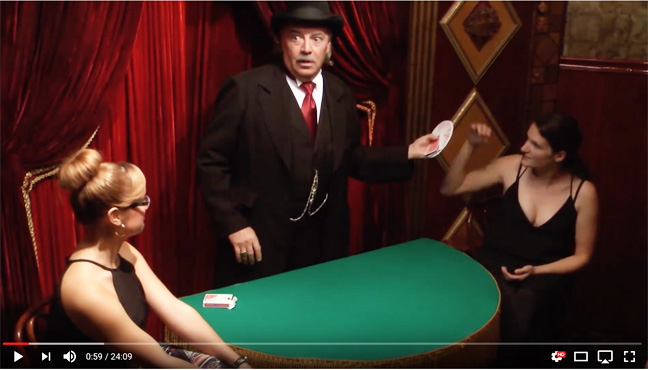 Pop Haydn at the Magic Castle. The second is that of Lucy Darling, alter ego of Carisa Hendrix and also working at the Castle, with an accent as endearing as Pop's. Carisa's Lucy character premiered a little over a year ago in Australia, and is as delightful and iconic as that of, say, Rob Zebrecky or Carl Ballantine. Lucy is gorgeous, edgy, and razor quick with her asides, like a Mae West or a Sarah Silverman. I'd quail to say the wrong thing in her hearing.  Lucy Darling at the Magic Castle. From Calgary, Alberta, Carisa is evidence, along with Dai Vernon, Doug Henning, David Ben and so many others, that the Very Best Magicians come from Canada. I feel like a moron for only recently noticing her. She has attended some U.S. conventions, but not the ones I did. OK, she was at more than one MAGIC Live, but Stan had her working behind the scenes. The July 2017 Vanish magazine issue praised her as "The 15 Year Overnight Success" and detailed each of those years (she is still only 31, and the article was written before "Lucy Darling"). And she has done a full podcast with Scott Wells, which I normally never miss, but I must have been listening to a sports podcast that week. So I've been playing catch up. You can see her in YouTube clips, and you can find additional podcasts. Recently Carisa teamed up with Kayla Drescher and started their own podcast, SheZam! Their first subject was Max Maven. (This was excellent, by the way.) From watching Carisa work, from listening to her converse with interviewers and interviewees, and from reading about her, I concur with a quote from the Vanish article: "Often she's the smartest guy in the room." But I digress. What got me interested here in both Pop and Lucy was their masterful interactions with their audiences. Just so good. They do magic proud. |
|
|
TOP SECRET -- Although I have rarely performed it, I have always been a fan of two-person mentalism. Virtually everyone's first awareness of such exhibitions is The Wizard conducted over the telephone. My father introduced me to that, and it was one of his two best magic tricks. (The other was the permanent vanish of a dime in a handkerchief.) As to professional two-person mind-reading acts, Will Dexter's book Everybody's Book of Magic introduced me to the Piddingtons, one of the greatest teams ever, recently seen on YouTube clips. I coveted Nelson's Master Code, but at $20 in the fifties I could not afford it. Annemannn's Practical Mental Effects combined several Jinx methods into a wonderful chapter "Psychic Codes." From that chapter I have performed Orville Meyer's A Practical Card Code, and I have performed a version of Annemann's Thoughts in the Air that I renamed Fourth Dimension in my first book. J.G. Thompson Jr's Moonlight Madness fascinated me, but I never constructed the flashlight signalling device it required. 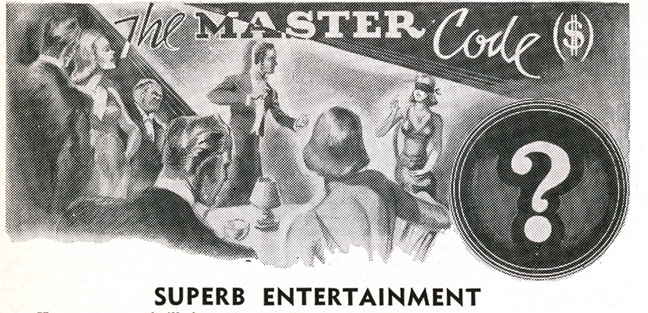 Nelson's pricey code. There were other sources along the way. Lewis Jones included a brilliant method called Transmission Impossible in Person to Person for encoding a birthday, a playing card, and a picture of anything in the universe with only fivea playing cards. Simon Lovell's Double Trouble from Simon Says is the most fun I've ever had performing this sort of thing. It's a pseudo code, dead easy to teach a partner. 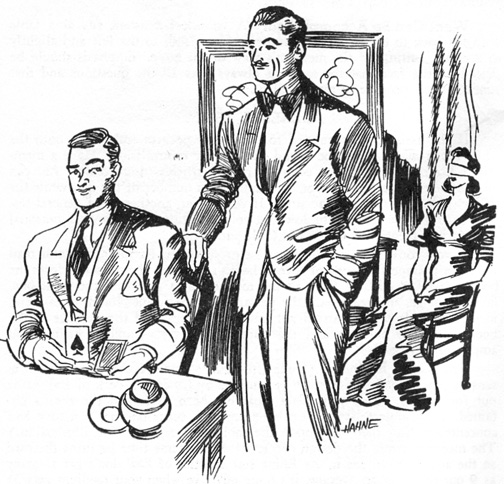 Moonlight Madness in action. And some people do it so well. My favorites of those I've witnessed doing two-person mentalism include Brian Gillis and Sisuepahn, Simon and Ginny Aronson, and the Evasons. Simon has promised to tip his method some day, and I suspect the Evasons of flat out mental telepathy. Maybe there is nothing to tip. All of which is context to bring us to a review of Decoded, the new Morgan & West download (or DVD) from Vanishing, Inc. What better material to associate with time travelling steampunk-era magicians? 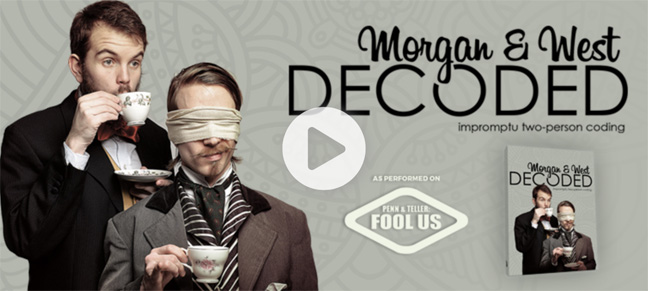 Two-person telepathy. Disc 1 (or Download 1) is Basic Training in Coding, simple yet baffling stuff you can do with your partner or teach a brand-new partner on the spot. For example, is a card you are holding up red or black? If several people are holding out closed fists, which fist contains a coin? Who picked up the coin first and gave it to whom? Or slightly more advanced, what is the value and suit of a card placed in a partner's hand behind his back. There are both physical (silent) and verbal codes. This is the easiest material to perform at a moment's notice, with no props.  Classic code act. Disc 2 (or Download 2) contains the stage material with which Rhys Morgan and Rob West have made a living, including a version of the routine they recently performed on "Penn & Teller: Fool Us." In that routine, Rob drops coins into a glass, and Rhys divines the value of the coin, or the total of several coins, simply by listening. For the finale, a credit card lands in the glass, and Rhys divines the type (Visa, Master Card?), the bank, and the last four digits. What makes the coding so baffling is not only the how but the when, and this is all clearly taught. It isn't terribly difficult. I should add that there are many professional practicalities to the routine that don't specifically involve "coding." A system is given for coding letters of the alphabet, perhaps the hardest item on the download, but also the strongest. The routine Sneak Thief duplicates the effect of Max Maven's trick Desire (check Prism, recently re-released) but uses secret transmission as the whole method. The mind reader identifies who wrote which four-letter word, and for the last person reveals the word without looking at it. Considerable attention is also given to encoding people's names. Complete routines are performed, and the instruction is all via Rhys and Rob just talking. This gives the video a certain My Dinner with Andre feel, just two talking heads, but hey, I liked that movie too. The course concludes with a discussion of how to write code routines that make sense and, most importantly, when not to use coding as your method, no matter how cool and fun coding is. Certainly a bargain at $35, just one of the many products Vanishing Inc. introduced at MAGIC Live. |
|
|
By second class I don't suggest inferior class, but merely an additional or second skill set, what has often been referred to in magic as an Allied Art. Let's expand on this ... THE ALLIED ARTS -- My first magic catalog hailed from Nelson Enterprises, purveyors of "Mental Magic and the Allied Arts." At twelve years old I had no inkling what the Allied Arts were until I turned to the Will Dexter book I mentioned above. Dexter devoted a chapter to the subject (mentalism itself had its own chapter), citing juggling, puppetry, chapeaugraphy, and troublewit as the dominant examples: "The first magical entertainers were the jongleurs, who performed a versatile mixture of programmes that would baffle many an entertainer today. Not only would they offer magical mysteries, but they would interlard these with juggling, possibly a little puppetry, a song or two, and even a few contemporary selections on the lute." Dexter lauds the juggler, often the most revered act on the bill at a magic convention, over the magician: Jugglers "... represent the very cream of talent. Their skill is uncanny compared with that of the conjurer, who depends upon subtlety and misdirection rather than absolute command of brain, muscle, and eye." I became impressed over the years at the versatility of our best known magicians, many who excelled at some Allied Art or another, talents sometimes incorporated into their acts, sometimes merely a sideline skill, and sometimes as an alternate source of income. In all cases these secondary skills distinguished them, if not as performers then as human beings. Names and abilities that immediately pop to mind: Jay Marshall could converse with his left hand. (And was no slouch at chapeaugraphy, troublewit, and Punch and Judy.) 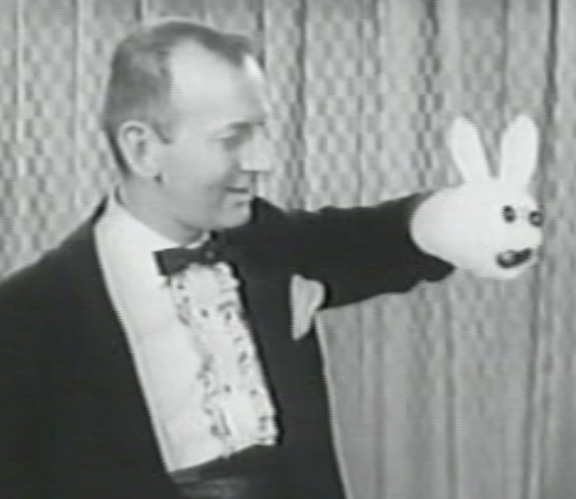 Jay and Lefty. Michael Carbonaro sculpts himself into characters via shaving cream. Doc Eason ties his own bow tie. Brian Gillis's partner Sisuepahn does the Lulu Hurst act. Mike Caveney juggles a cup of coffee. (Until Mike's boxed set of books came out, I thought this was a magic trick, not juggling. I still have my suspicions.) Juggler Charlie Frye does fantastic magic. (Which one is the Allied Art? He can also do a mean Flea Circus. And is the funniest guy in this list.) Dai Vernon made a living cutting silhouettes. John Archer plays the ukulele. Johnny Thompson plays the harmonica. Harry Lorayne remembers the names of everyone in the audience. (And does lightning fast math.)  Harry introduces everyone in the audience on "I've Got a Secret." Mike Caldwell could flip in the air and land on his back. Amazing Johnathan and Brian Gillis boxed. Each other. Brian Gillis and Martin Lewis raced motorcycles. Martin Lewis performs Nankin Tamasudare. Ricky Jay throws cards really far. Mac King is a master chef. Carisa Hendrix is a world-champion fire-eater. Mike Close plays the piano. So does Howie Schwarzman. Milt Larsen can snatch a tablecloth off a fully set dinner table. Darren Romeo sings show tunes. Rob Zabrecky dances really silly.  I'm going to dance for you. Sean Begonia does amazing stunts with a yoyo. Tom Mullica could devour lit cigarettes. Harry Anderson had a soft spot for chapeaugraphy. Ian Rowland slices cards into fantastic and impossible pieces of art. Jamie D. Grant puts decks of cards into bottles. David Blaine holds his breath like forever. Milbourne Christopher could tie amazing rope knots. Roy had extraordinary rapport with tigers and other animals. And so on. I'm sure you have your own list. Meanwhile, what is your secondary talent? |
|
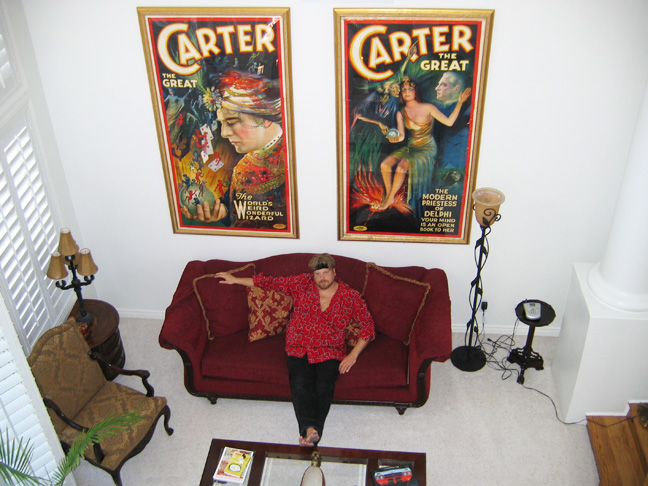 Happy birthday!
Create something cool to show everyone at Halloween.
Follow us on Twitter. Little Egypt Magic is the erratically updated web site of Steve Bryant, spawned (the site, not Steve) by a former internet magazine known as The Little Egypt Gazette/for magicians only. Steve Bryant is an obscure magician and writer who generates this site from an iMac in Bloomington, Indiana. He used to frequently journey to and perform magic in Little Egypt, the local name for extreme southern Illinois, where the towns bear such names as Cairo, Thebes, and Karnak. Past issues of this web site: Index to Past Issues Notice: Any limited use of copyrighted images or quoted text is considered fair use, usually to review whatever product or event that is under discussion. If you object to use of any material, please get in touch and it will be cheerfully removed. |
A JSB Creations product
Copyright© 2018 by Steve Bryant